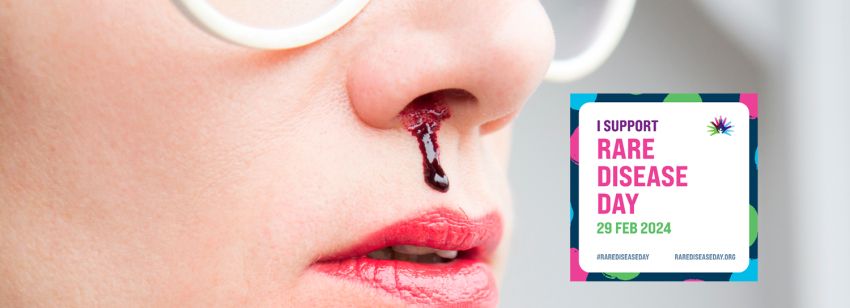Morbus Osler (HHT)
More than just nosebleeds
The extent and location of the abnormal blood vessels determine the symptom burden and quality of life that HHT patients experience. The burden of the disease can vary greatly, even among family members with the same pathology: Some may be asymptomatic or have only mild symptoms, while others may be severely affected by epistaxis to the extent that they are unable to carry out their daily activities or suffer from sleep disturbance.
Intense nosebleeds
Frequent, sometimes prolonged and severe nosebleeds (epistaxis) are the most common symptom of HHT, affecting over 90% of diagnosed patients and often occurring several times a day. Epistaxis is also the most important symptom of the disease in terms of quality of life and, if severe and prolonged, can lead to anaemia or iron deficiency anaemia. The unpredictability of epistaxis and the need for immediate countermeasures often leads to social withdrawal and a significant reduction in quality of life. Recurrent nosebleeds are caused by pathological dilation of blood vessels in the mucosa, known as telangiectasias, which can rupture at minimal mechanical stimuli such as airflow. Causative mutations within the transforming growth factor-beta (TGF-beta) signalling pathway led to improper capillary formation between arteries and veins, contributing to telangiectasias and HHT in general. The manifestation of telangiectasias varies greatly from patient to patient, with most patients having mucosal and externally visible telangiectasias on the hands, lips or face.
When visceral and extensive changes in the blood vessels occur, they are called arteriovenous malformations (AVMs). These often occult malformations can be found in over 30% of HHT patients and represent another significant health risk, potentially leading to serious complications and even death. Located mainly in the lungs (15-50%), liver (30-50%) and gastrointestinal tract (20-80%), AVMs lead to serious complications in some patients, such as reduced blood oxygenation or right heart failure, which can even lead to death. Gastrointestinal bleeding, combined with the already significant blood loss from epistaxis and pulmonary complications from AVMs, poses a significant risk to the health of HHT patients.
Diagnosis with analysis
The diagnosis of HHT is usually based on clinical features and genetic analysis and is confirmed if 3 of the 4 Curaçao criteria (frequent and spontaneous epistaxis, presence of (multiple) telangiectasias, detectable AVMs, heredity) are positive. As typical HHT symptoms often manifest during puberty, early and definitive diagnosis in children is challenging. The prevalence of HHT is estimated to be between 1.25 and 2 patients per 10,000 population.
Only symptomatic treatment approaches
The treatment of HHT focuses on relieving symptoms and preventing complications. Preventive measures to treat epistaxis include keeping the nasal mucous membranes moist with nasal ointments/oils, stopping and preventing bleeding with tamponades or surgery (including laser therapy, septal dermoplasty) and, as a final stage of escalation, complete nasal occlusion. Supportive medical treatment with hormones, beta-blockers, angiogenesis inhibitors or antifibrinolytics may be used. Tranexamic acid is the only drug approved in Germany for the treatment of HHT that is also used exclusively for the treatment of epistaxis. As there is no causal therapeutic approach that directly targets the TGF-beta signalling pathway, available therapies have limited efficacy and symptoms usually recur. Depending on the size, location and symptoms, AVMs are treated with laser therapy, embolisation, surgical resection or angiogenesis inhibitors such as thalidomide or bevacizumab.
It is important to note that both the drug and non-drug therapies used to treat epistaxis and the therapeutic options used to treat AVMs and associated conditions are symptomatic approaches. At present, there are no therapies available that allow curative, targeted treatment of HHT. Regular medical check-ups and careful monitoring of symptoms play a crucial role in the lives of HHT patients in order to detect and treat potential problems at an early stage.
SKC consulting is dedicated to support market access for innovative drugs for patients with previously missing or inadequate therapy options, with particular emphasis on rare diseases. Therefore, on the occasion of Rare Disease Day on February 29th, we would like to contribute with this article to raising awareness of rare genetic diseases such as hereditary hemorrhagic telangiectasia (HHT).
Sources:
- Morbus Osler Selbsthilfe e.V.
- Seebauer CT et al., Diagnostik und Behandlung der hereditären hämorrhagischen Teleangiektasie, Laryngo-Rhino-Otol 2020; 99: 682–693
- Curehht.org (accessed 12.02.2024)
- Faughnan ME et al., Second International Guidelines for the Diagnosis and Management of Hereditary Hemorrhagic Telangiectasia. Ann Intern Med. 2020 Dec 15;173(12):989-1001



